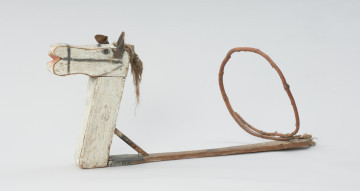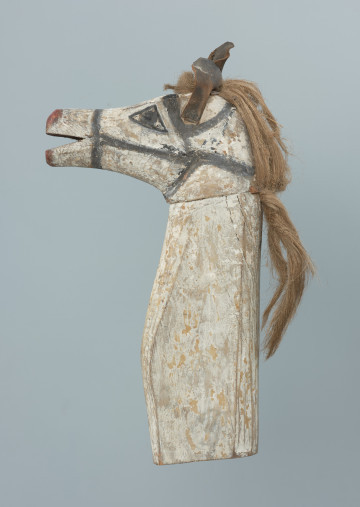
Hoarse - ceremonial item
1. połowa XX wieku
National Museum in Szczecin
Part of the collection: Material culture of West Pomerania
During the Christmas and carnival period, merry processions of masquerades would go around the villages, visiting homesteads and wishing their inhabitants prosperity and good luck. The carol singers were often dressed up as human characters, such as an Old Man, a Gypsy or a Jew, but the animal creatures would always play the first fiddle. One of them, appearing more often during the carnival than at Christmas, was a horse. Its presence in the carol procession was related to the qualities that were ascribed to this strong and beautiful animal in the folk beliefs. A horse symbolised bravery, pride, vitality, fertility and health. These traits were meant to be passed on to the inhabitants of the household that was visited by the horse merrily romping around the room. In some regions it was customary to carol with a real horse, decorated with colourful ribbons and paper flowers: “The carol singers would go with the horse around the room or the table, according to the supposed movement of the sun (...) This custom was combined with wishing good fortune and sprinkling grain which was – supposedly – an older form of the performance with a horse effigy.” It was a good omen when the animal fouled inside the house, which questioned people unanimously believed to be a sign of good luck on the farm for the entire year” (Józef Nowak Zespoły kolędnicze z kozą i z koniem na tomaszowskim pograniczu polsko-ukraińskim). The presented ceremonial horse effigy comes from the beginning of the 20th century, probably from the Pyrzyce area. The horse’s head and neck, made of wood and coated with leather, are depicted very realistically. Characteristically, the effigy was painted white, as white horses are a symbol of life. This horse is a unique, homemade product, its creator is unknown. Originally it was in the collection of the Pommersches Landesmuseum Stettin.
Agnieszka Słowińska
Author / creator
Dimensions
cały obiekt: height: 40 cm, width: 50 cm
Creation time / dating
Creation / finding place
Identification number
Location / status

1. połowa XX wieku
National Museum in Szczecin

National Museum in Szczecin

1. połowa XX wieku
National Museum in Szczecin
DISCOVER this TOPIC
National Museum in Szczecin
DISCOVER this PATH
Educational path